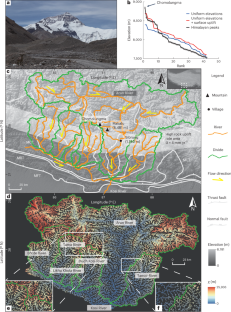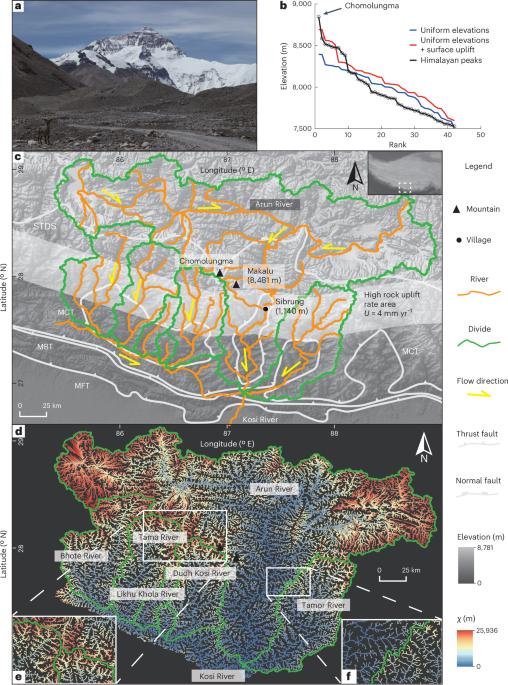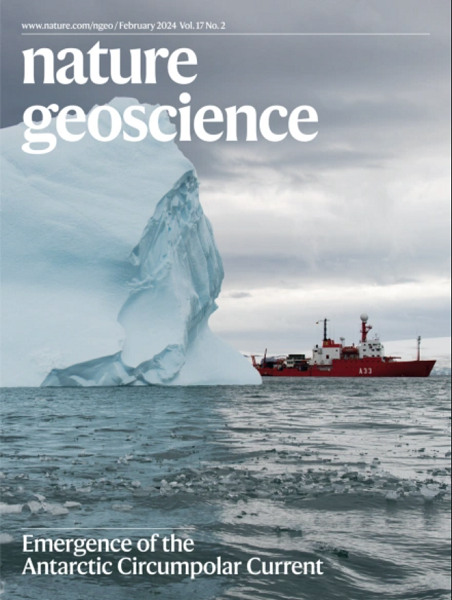Recent uplift of Chomolungma enhanced by river drainage piracy
IF 15.7
1区 地球科学
Q1 GEOSCIENCES, MULTIDISCIPLINARY
引用次数: 0
Abstract
The Himalayas, which host glaciers, modulate the Indian Monsoon and create an arid Tibetan Plateau, play a vital role in distributing freshwater resources to the world’s most populous regions. The Himalayas formed under prolonged crustal thickening and erosion by glaciers and rivers. Chomolungma (8,849 m)—also known as Mount Everest or Sagarmāthā—is higher than surrounding peaks, and GPS measurements suggest a higher uplift rate in recent years than the long-term trend. Here we analyse the potential contribution of a river capture event in the Kosi River drainage basin on the renewed surface uplift of Chomolungma. We numerically reconstruct the capture process using a simple stream power model combined with nonlinear inverse methods constrained by modern river profiles. Our best-fit model suggests the capture event occurred approximately 89 thousand years ago and caused acceleration of downstream incision rates. Flexural models estimate this non-steady erosion triggers isostatic response and surface uplift over a broad geographical area. We suggest that part of Chomolungma’s anomalous elevation (~15–50 m) can be explained as the isostatic response to capture-triggered river incision, highlighting the complex interplay between geological dynamics and the formation of topographic features. The recent uptick in surface uplift of Chomolungma (Mount Everest) can be partly attributed to isostatic rebound due to increased erosion following a river capture event, according to river evolution and flexural modelling.


乔木隆玛峰近期的隆起因河水盗排而加剧
喜马拉雅山脉拥有冰川,调节印度季风,并形成了干旱的青藏高原,在为世界上人口最多的地区分配淡水资源方面发挥着至关重要的作用。喜马拉雅山脉是在地壳长期增厚以及冰川和河流的侵蚀作用下形成的。珠穆朗玛峰(海拔 8849 米)--又称珠穆朗玛峰或萨迦玛峰--高于周围的山峰,全球定位系统的测量结果表明,近年来的隆起速度高于长期趋势。在这里,我们分析了科西河流域的河流截流事件对珠穆朗玛峰地表重新隆起的潜在影响。我们利用一个简单的河流动力模型,结合以现代河流剖面为约束的非线性反演方法,对河流挟带过程进行了数值重建。我们的最佳拟合模型表明,捕获事件发生在距今约 8.9 万年前,并导致下游侵蚀速度加快。据挠曲模型估计,这种非稳定的侵蚀引发了等静力反应和地表隆起,波及范围很广。我们认为,珠穆朗玛峰的部分异常海拔(约15-50米)可以解释为捕获引发的河流侵蚀的等静压反应,这凸显了地质动态与地形特征形成之间复杂的相互作用。
本文章由计算机程序翻译,如有差异,请以英文原文为准。
求助全文
约1分钟内获得全文
求助全文
来源期刊

Nature Geoscience
地学-地球科学综合
CiteScore
26.70
自引率
1.60%
发文量
187
审稿时长
3.3 months
期刊介绍:
Nature Geoscience is a monthly interdisciplinary journal that gathers top-tier research spanning Earth Sciences and related fields.
The journal covers all geoscience disciplines, including fieldwork, modeling, and theoretical studies.
Topics include atmospheric science, biogeochemistry, climate science, geobiology, geochemistry, geoinformatics, remote sensing, geology, geomagnetism, paleomagnetism, geomorphology, geophysics, glaciology, hydrology, limnology, mineralogy, oceanography, paleontology, paleoclimatology, paleoceanography, petrology, planetary science, seismology, space physics, tectonics, and volcanology.
Nature Geoscience upholds its commitment to publishing significant, high-quality Earth Sciences research through fair, rapid, and rigorous peer review, overseen by a team of full-time professional editors.
 求助内容:
求助内容: 应助结果提醒方式:
应助结果提醒方式:


